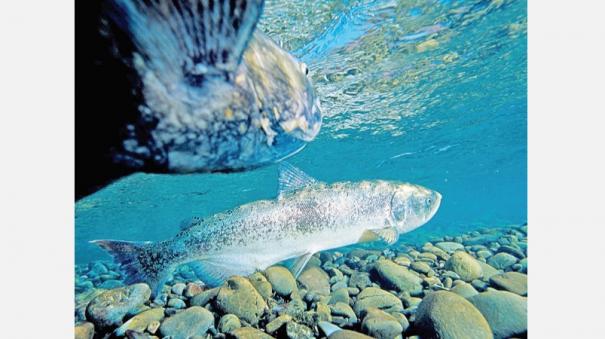Published : 27 Feb 2020 10:10 AM
Last Updated : 27 Feb 2020 10:10 AM
மொழிபெயர்ப்பு: பிராணவாயு இல்லாமலே உயிர்வாழும் உயிரினம் கண்டுபிடிப்பு!

Animal that doesn't survive on oxygen discovered
Jerusalem
Scientists have discovered an animal that does not need oxygen to produce energy needed for its survival, a finding that changes one of science's assumptions about the animal world.
The tiny, less than 10-celled parasite Henneguya salminicola lives in salmon muscle, according to the finding published on Tuesday in the journal PNAS.
As it evolved, the animal, which is a relative of jellyfish and corals, gave up breathing and consuming oxygen -- or became anaerobic -- to produce energy.
"Our discovery shows that evolution can go in strange directions. Aerobic respiration is a major source of energy, and yet we found an animal that gave up this critical pathway," said Dorothee Huchon, a professor at Tel Aviv University (TAU) in Israel.
The researchers noted that the parasite's anaerobic nature was an accidental discovery. While assembling the Henneguya genome, Huchon found that it did not include a mitochondrial genome.
The mitochondria is the powerhouse of the cell where oxygen is captured to make energy, so its absence indicated that the animal was not breathing oxygen.
The assumption that all animals are breathing oxygen was based, among other things, on the fact that animals are multicellular, highly developed organisms, which first appeared on the Earth when oxygen levels rose, they said.
"It's not yet clear to us how the parasite generates energy," Huchon said."It may be drawing it from the surrounding fish cells, or it may have a different type of respiration such as oxygen-free breathing, which typically characterises anaerobic non-animal organisms," she said.According to Huchon, the discovery bears enormous significance for evolutionary research.
- PTI
பிராணவாயு இல்லாமலே உயிர்வாழும் உயிரினம் கண்டுபிடிப்பு!
ஜெருசலேம்
பிராணவாயு இல்லாமல் கூட உயிர்வாழ கூடிய உயிரினத்தை விஞ்ஞானிகள் கண்டு பிடித்திருக்கிறார்கள். விலங்கினங்கள் குறித்த அறிவியல் பார்வையை இந்த கண்டுபிடிப்பு புரட்டிப்போட்டுள்ளது. சால்மன் மீன்களின் தசையில் வாழக்கூடிய உயிரினம் இது. 10 உயிரணுக்களுக்கும் குறைவாகக் கொண்ட இந்த ஒட்டுண்ணிக்கு ஹென்னிகுயா சால்மினிகோலா என்று பெயரிடப்பட்டுள்ளது. இது குறித்த தகவல் பி.என்.ஏ.எஸ். ஆய்விதழில் வெளியாகி இருக்கிறது.
ஜெல்லிமீன் மற்றும் பவளப்பாறை இனத்தை சேர்ந்த உயிரினமாக இந்த ஒட்டுண்ணி கருதப்படுகிறது. இவை பிராணவாயுவை உள்வாங்குவதும் இல்லை, மூச்சுவிடுவதும் இல்லையாம். இந்த ஆராய்ச்சி குறித்து இஸ்ரேலைச் சேர்ந்த டெல் அவிவ் பல்கலைக் கழக பேராசிரியை டொரோத்தீ ஹச்சன் கூறுகையில், “பரிணாம வளர்ச்சியின் பயணம் விசித்திரமான திசையில் இருக்ககூடும் என்பதை இந்த கண்டுபிடிப்பு காட்டுகிறது.
பிராணவாயுவை உள்வாங்கி வளர்வதுதான் உயிரினங்களின் அடிப்படையாகும். ஆனால், பிராணவாயு தேவை இல்லை என்று அதை உதறித்தள்ளக்கூடிய உயிரினம் இருக்கிறது என்பதை இப்போது நாம் கண்டுபிடித்துவிட்டோம்” என்று தெரிவித்தார்.
இந்நிலையில் ஹென்னிகுயா சால்மினிகோலா ஒட்டுண்ணியை ஆராய்ச்சியாளர்கள் தற்செயலாகக் கண்டுபிடித்துள்ளனர். இதன் உடலில் சுவாசிக்கும் நுண்ணுறுப்பு இல்லாத காரணத்தினால் இதற்கு பிராணவாயு தேவை இல்லையாம். பூமியில் பிராணவாயுவின் அளவு அதிகரித்த பிறகுதான் பல உயிரணுக்களை கொண்ட உயிரினங்கள் தோன்றின என்று நம்பப்படுகிறது.
இதனால் அனைத்து விலங்கினங்களும் பிராணவாயுவை சுவாசிக்கின்றன என்ற அனுமானமும் இதுவரை நீடித்தது என்கிறனர் ஆராய்ச்சியாளர்கள். இப்படி இருக்கையில், ஒட்டுண்ணிகள் எப்படி பிராணவாயு இன்றி ஆற்றலை உற்பத்தி செய்கின்றன என்பது இன்னும் புதிராகவே உள்ளது என்று பேராசிரியைடொரோத்தீ ஹச்சன் கூறியுள்ளார்.
மேலும் அவர் கூறுகையில், “ஒருவேளை இந்த ஒட்டுண்ணி அதனை சுற்றி இருக்கும் மீனுடைய அணுக்களில் இருந்து ஆற்றலை தன்னகத்தே இழுத்துக் கொள்ளும். அல்லது பிராணவாயு இல்லாமலே சுவாசிக்கும் முறையை அது பின்பற்றலாம். பொதுவாக சுவாசிக்கும் நுண்ணுறுப்பு இல்லாத உயிரினங்களின் குணாம்சம் இது” என்றார். பரிணாம வளர்ச்சி குறித்த ஆராய்ச்சியில் இந்த ஒட்டுண்ணியின் கண்டுபிடிப்பு முக்கிய நகர்வாகப் பார்க்கப்படுகிறது.
- பிடிஐ
FOLLOW US
Sign up to receive our newsletter in your inbox every day!


WRITE A COMMENT